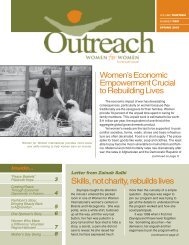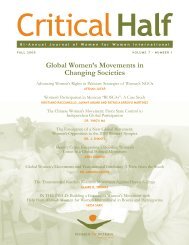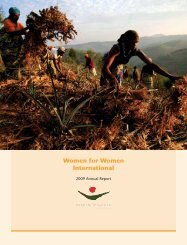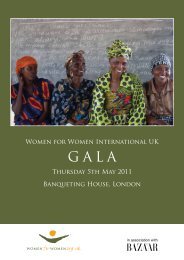Gender and Constitution Building - Women for Women International
Gender and Constitution Building - Women for Women International
Gender and Constitution Building - Women for Women International
You also want an ePaper? Increase the reach of your titles
YUMPU automatically turns print PDFs into web optimized ePapers that Google loves.
The New Afghan <strong>Constitution</strong>: How<br />
<strong>Women</strong> Succeeded in Ensuring Certain<br />
Rights <strong>and</strong> What Challenges Remain<br />
HORIA MOSADIQ<br />
Introduction<br />
A constitution is defined as “the basic principles <strong>and</strong><br />
laws of a nation, state, or social group that determine<br />
the powers <strong>and</strong> duties of the government <strong>and</strong> guarantee<br />
certain rights to the people in it.” 1 The powers <strong>and</strong> duties<br />
of government, <strong>and</strong> the rights which people are guaranteed,<br />
are the tangible results of an internal process<br />
translating history <strong>and</strong> experience into an institutional<br />
framework. No two countries have the same history <strong>and</strong><br />
experiences <strong>and</strong> each country must consider its own history,<br />
characteristics <strong>and</strong> problems while drafting a constitution.<br />
There<strong>for</strong>e, each country’s constitution should<br />
reflect that country’s unique circumstances.<br />
Additionally, over the last half century, the international<br />
community has reached some consensus on a minimum<br />
st<strong>and</strong>ard of human rights that individual governments<br />
must guarantee to their citizens. There<strong>for</strong>e, any<br />
new constitution should take into account provisions of<br />
the United Nations Charter, the Universal Declaration<br />
of Human Rights <strong>and</strong> other international treaties to<br />
which the state is a party. Although a constitution in <strong>and</strong><br />
of itself can never be sufficient to prevent human rights<br />
violations <strong>and</strong> guarantee women’s rights, a constitution<br />
that specifically provides <strong>for</strong> the protection of fundamental<br />
human rights <strong>and</strong> freedoms can be an important<br />
starting point <strong>for</strong> remedying past violations <strong>and</strong> preventing<br />
future ones.<br />
This article examines the recent constitution-building<br />
exercises <strong>and</strong> developments in Afghanistan <strong>and</strong> attempts<br />
to glean some lessons in gender issues that may<br />
be relevant in other post-conflict nations facing the challenges<br />
of drafting <strong>and</strong> adopting new constitutions.<br />
<strong>Women</strong> in Afghanistan<br />
Afghanistan is an Islamic <strong>and</strong> culturally traditional<br />
country. Throughout Afghanistan’s history, real discussion<br />
about women’s rights has been stifled by both religious<br />
fundamentalists <strong>and</strong> the strength of cultural tradi-<br />
tions. Indeed, traditional cultural values are often even<br />
more influential than <strong>for</strong>mal religious ones. For example,<br />
according to Islamic law, a woman has the right to select<br />
her own life partner, but in practice this choice is often<br />
made <strong>for</strong> her. Also, under Islamic law, a women is entitled<br />
to inherit property after a spouse or relative dies,<br />
but in practice, if a woman attempts to en<strong>for</strong>ce this right,<br />
her community will shun her.<br />
There has been almost constant warfare in Afghanistan<br />
<strong>for</strong> the past quarter century, including the international<br />
conflict with Russia’s Red Army, which lasted a<br />
total of 14 years <strong>and</strong> more than nine years of civil war.<br />
This constant state of conflict has rendered Afghanistan<br />
one of the poorest countries in the world. 2 One consequence<br />
of such extreme poverty is that more than half<br />
of the women in Afghanistan are illiterate <strong>and</strong> unaware<br />
of their rights. During the rule of the Taliban, the most<br />
extremist regime in Afghanistan’s history, women were<br />
subjected to behavioral, dress <strong>and</strong> movement limitations.<br />
Because of the social restrictions placed on women, even<br />
those women who are able to read have very little awareness<br />
of their legal rights.<br />
Since the 1920s, progress on women’s rights in Afghanistan<br />
has faced almost overwhelming opposition<br />
from religious fundamentalists <strong>and</strong> those who have promoted<br />
their own underst<strong>and</strong>ings of the country’s traditions.<br />
Afghanistan is a male dominated society. Most of<br />
the Islamic verdicts <strong>and</strong> rules that could benefit women<br />
have been misinterpreted by Mullahs 3 <strong>and</strong> other religious<br />
figures in various communities. Because of fundamentalist<br />
extremists <strong>and</strong> prolonged war, the struggle <strong>for</strong><br />
women’s rights continues today.<br />
After the terrorist attacks on the World Trade Center<br />
<strong>and</strong> Pentagon on September 11, 2001, the plight of<br />
Afghan women living under the Taliban regime became<br />
a global concern. After the US military invasion of Afghanistan<br />
in October 2001, which resulted in the collapse<br />
of the Taliban regime, women in Afghanistan seized<br />
CRITICAL HALF 29







